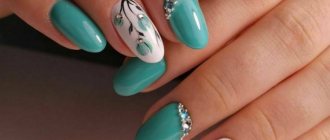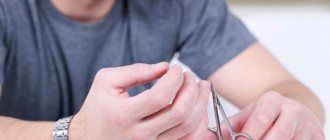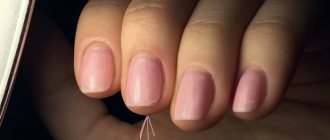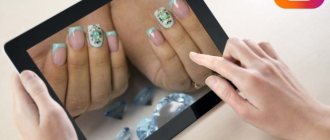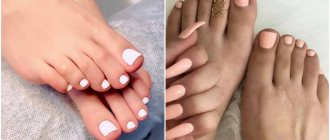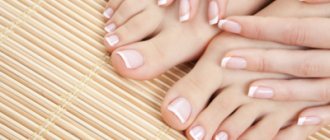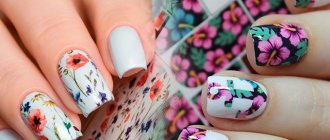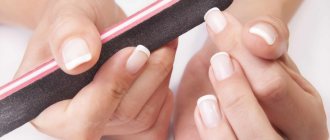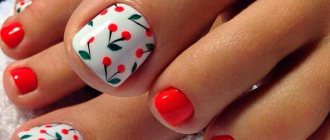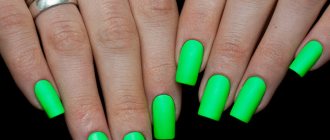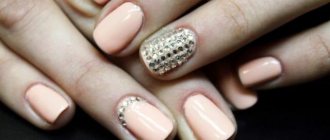Tools and materials: list
How to properly treat your nails at home? First you need to prepare all the tools and materials that may be useful during the manicure process. Stores today offer a huge selection of hand care products. To perform a manicure yourself you may need:
- nail polish remover;
- nail files;
- wooden sticks for pushing back cuticles;
- nail scissors or tweezers;
- cuticle oil;
- softening agent;
- cotton pads;
- steam bath;
- hand skin care cream;
- hand scrub;
- hydrogen peroxide;
- brush with natural bristles;
- nail polish;
- base coat (base);
- varnish fixer (finish);
- waffle towel or cotton napkin.
Home nail care
Tools
First, scissors. It is not recommended to trim your nails with them. To avoid delamination, it is better to remove the length by filing. But cuticle scissors with thin, sharp blades will come in handy to remove hangnails carefully, without cuts. Choose professional tools made from high quality stainless steel. When closing, the blades of the scissors should converge smoothly, be smooth and perfectly polished.
Of course, nail care and manicure are impossible without nail files.
The main advice is to forget about metal ones: they injure and cause peeling. If your nails are fragile and brittle, a fine-grained glass, crystal or ceramic file would be the best option. Such files act as carefully as possible and seal the edge of the nail.
via GIPHY
You can also use files on a cardboard or plastic base, onto which the working coating is glued. They differ in the degree of hardness, or abrasiveness, which is measured in special units - grit, and is usually indicated directly on the file. The higher the numbers, the more gentle the effect of the tool on the nails. Remember: the optimal abrasiveness of a file for natural nails is from 180 to 240 grit.
In addition to files for cutting length and giving nails the desired shape, there are also polishers and buffs - files in the form of a polishing bar. These are soft tools with abrasiveness from 240 to 1200 grit, which grind the nail plates, removing all roughness, and giving a mirror shine.
There are also files for side ridges - rough and dry skin on the sides of the nails really spoils the appearance of the fingers, and cutting it off with scissors is not recommended. Using a special laser file, it can be easily and accurately sanded.
In addition, to care for your nails at home, you will need orange wood sticks to push back the cuticles, a manicure bath - a professional or just a bowl of suitable size, and cotton pads.
Remember that manicure tools, like a toothbrush, are a strictly individual thing. Don't even share them with your sister or best friend. Buying a Glasperlene sterilizer or a dry-heat oven, like in a salon, will be unnecessary, but an antiseptic spray for treating instruments will not hurt, even if only one person uses them.
Nail and cuticle products
It is better to have two hand creams at once - with different textures. Lightweight and easily absorbed, leaving no greasy residue, carry it with you and use it after every hand washing. Store the thick and oily cream-balm on the nightstand near your bed and apply it at night. Good hand creams contain the following ingredients: vitamins C and E, lanolin, allantoin, nourishing oils (olives, avocado, wheat germ, mango and others), plant extracts. A not at all superfluous thing in hand cream is SPF.
You just can't get by with creams. The cuticle needs special care - oil. It will soften the cuticle and side ridges, giving the fingers a neat, well-groomed appearance, and nourish the base of the nails with microelements, polyunsaturated acids and other benefits, making them healthier and stronger. Oil in pencil form is convenient to carry in your bag, and a bottle with a brush or pipette is a “stationary” option.
via GIPHY
To take care of your nails with a homemade unedged manicure, you need to purchase a remover - a product that softens dry cuticles so that they can then be easily removed. Removers “dissolve” unnecessary skin either through alkali or fruit acids. In the first case, they act quite aggressively, and you should not keep the product on the skin longer than the time recommended by the manufacturer.
Secrets of choosing: nail polish remover
It is better to choose a nail polish remover that does not contain acetone, which has a negative effect on the nail plate, although it quickly washes off the old coating. With frequent use of acetone, nails begin to flake and become dull. To minimize harm, various nourishing and moisturizing components are added to the liquid (in fact, it may not be a liquid at all, but a gel or cream). Some products contain vitamins A, E, group B, essential oils, extracts of medicinal herbs, mineral ingredients (calcium) that protect the nail plate from brittleness and delamination.
Sequencing
In order to properly treat your nails and achieve the same effect as a professional nail artist, you must follow a logical sequence of actions and basic principles of technology. If you do everything correctly, then you simply won’t need to go to the salon anymore.
Nail shape
You should start by filing and giving your nails the desired shape. It can be a circle, a square, a rounded square, or literally any shape you choose. Not sure which way to go or where to stop? The choice of nail shape, as a rule, depends on personal preferences, but professionals have their own methods that allow you to shape the nail quite safely in any situation.
Pay attention to the natural shape of your nail plate. If it is more rounded or more square, then it makes sense to reflect the shape of the bottom of the nail in the top. Keep in mind that square nails on top suit everyone, but an oval tip will not go well with a square base. If you want a soft nail shape, but have a square nail plate, make the top in the shape of a rounded square.
In principle, you should not cut your nails if they are too long; it is better to be patient and carefully file them - this will avoid microcracks in the nails, which are the main cause of delamination of the nail plate.
Buff
After you have filed your nails to the desired shape, they need to be polished, creating a smooth surface on which the base, color and top will ideally fit. A buff is a special pad that is somewhat similar to a nail file, but it is much softer and its abrasive effect is much more gentle. That is why it is used to polish nails without damaging the skin on the sides of the nail plate.
On a smoother surface, the coating adheres much better, lasts longer and spends much more time starting to crack and come off. Among other things, the buff helps to make sure that there are no irregularities or roughness left on the surface of the nail that will be visible after coating.
Cuticle care
To give your fingers and nails the best care and softness, you need to treat your cuticles with a special oil. In addition to the fact that this has a good effect on the nail plate and the rate of nail growth, it will help remove all excess and open the nail as much as possible for coating.
Despite the fact that cuticles are trimmed in many salons, you should not do this at home. For this procedure, very thin and sharp scissors are used, and even if you manage to do this without injury on one hand, problems will most likely arise with the other, and no one wants to injure themselves. In the worst case scenario, you could end up with an infection in your nail bed, so it's best to avoid cutting your cuticles yourself.
We should not forget that the cuticle needs to be moisturized constantly, and not just during the manicure process. This, among other things, helps to avoid sensitivity of the skin around the nails and the formation of hangnails. There are many cuticle products designed to strengthen nails and smooth the skin, making them more manageable and less prone to breakage. Look for those that are oil-based, their effect is faster and longer lasting.
Cleansing
After the oil has been properly absorbed into the skin and nails, making them soft and nourishing, use a brush to clean the nail plate of excess oil. In salons, a special brush is used for this, but you can replace it with a common toothbrush.
It is very important to remove all excess oil, since the base coat on nails that are not clean enough will begin to crack and come off much faster, and then your manicure will not last long.
Base coat
Finally it's time to work on the coating. It all starts with a base coat, it allows for a more even application of color and will also prevent nail polish from staining your nails (some nail polishes can penetrate so deeply into the nail plate that they change its natural color; a base coat will prevent this from happening). It is worth drying the base for a few minutes before moving on to the next step.
Color coating
Now you can move on to painting your nails with color. You can use one color, you can combine them, you can draw something on your nails - everything is limited solely by your imagination. Always apply two coats of color, waiting a few minutes in between to avoid dents or bubbles. Take your time, as you won't have any problems applying the polish with your dominant hand, but it will definitely become more difficult in the opposite direction.
It is important to choose varnishes with a convenient consistency and a brush so that there are no unnecessary problems with controlling the application. If something is smudged, let the polish dry, dip a cotton swab in nail polish remover and then correct the mistakes.
Top (top cover)
After all the nails have been coated with color, it’s time to move on to the final stage - topcoat. It locks in color, gives the underlying layers more strength and protection, provides a high-gloss shine to your nails, and prevents chipping in the finish. It can be applied every few days to make your manicure last longer and look fresher.
Voila, your home manicure is ready! It was much easier than expected, right? The most important thing is to constantly monitor the condition of the coating, sufficient hydration of the skin of your hands and the integrity of the color on your nails. The key to making sure everything looks perfect is following the steps. They are simple, but care and scrupulousness will help you achieve a perfect result and forget about the need to go to a nail salon. A little effort, a little dexterity and practice, and you can easily reproduce even the most intricate patterns on your nails, without worrying about how long the coating will last or how to change a boring pattern.
File, wooden sticks and scissors
It is better to buy a glass file. The tool does not act so aggressively on the nails and does not provoke separation. Polishing files may come in handy. These are made in the form of a parallelepiped. The finish and number on each side is different. You need to polish your nails one by one (depending on the edge number). The procedure should be carried out no more than once a month.
Often, disposable orange sticks are used for manicure to push back the cuticles. Orange wood is distinguished by antiseptic properties; the wood has a dense, but at the same time very soft texture, and absorbs moisture well. The length of the stick varies from 9 to 18 cm, the thickness on average is 3-5 mm. There are options with rubber tips, but the usefulness of such a tool for nails is much lower.
Wooden sticks can be replaced with metal instruments made of high-quality medical steel. They are reusable, easy to disinfect and can perform all the functions of an orange stick. But you need to use the tool very carefully, because a metal spatula can seriously damage the nail plate. Therefore, it is better to use models with rubber tips.
The size of manicure scissors or special tweezers is chosen based on the convenience of the woman herself. It is advisable to purchase tools made of high-quality steel from well-known manufacturers. Such scissors will have to be sharpened very rarely, and there will be no problems with manicure.
So different: how to work correctly with different types of cuticle
The cuticle is a real “fine matter” of manicure art. It can be healthy or problematic, and for any type of cuticle it is very important to choose the right manicure. How to remove the cuticle correctly and not cause harm to the client?
Dry cuticle: how to remove and care
How to work with wet cuticle correctly
What to do if the cuticle is “creeping”
How to treat tight cuticles
How to cure injured cuticle
Dry cuticle: how to remove and care
Dry cuticles can be a real headache for its owner. A dry, unmoisturized cuticle protects the area around the nail less well, and hangnails are more likely to appear on it. And this creates a threat of inflammation and even fungal diseases. Needless to say, dry cuticles make your nails look simply untidy?
A nail technician should be careful when treating dry cuticles. A trimmed manicure is not suitable - when removing with scissors or a tweeter, there is a risk of damaging thin skin. Due to closely spaced capillaries, the cut cuticle may begin to “bleed,” which is not only painful, but also fraught with infection.
The best option for working with dry cuticles is a hardware manicure. With the help of a properly selected cutter, pterygium can be cleaned off without harming the sensitive cuticle. After all, with this method, the keratinized skin is not cut off, but carefully polished.
In the future, the dry cuticle should be treated with a special oil. Organic products based on sweet almond and jojoba oils and moisturizers are perfect. Additionally, it is imperative to remind the client to avoid contact with chemicals and hard water without gloves. It is precisely this aggressive environment that most often leads to dry nails and cuticles. However, it can also be due to problems in the body such as stress, malnutrition and even certain medications.
How to work with wet cuticle correctly
Wet cuticles may be associated with hand hyperhidrosis. It is highly elastic, so it should be removed with extreme caution. If handled roughly, the wet cuticle may tear!
A combined manicure is best for wet cuticles. Before removing such a cuticle, it must be dried. This will make it much easier to remove dead skin. After this, the cuticle is pushed back with a pusher, and the pterygium is cleaned with a cutter.
Cleaning with a cutter should be done in such a way as to lift the wet cuticle. This will make it much more convenient to cut it with manicure scissors. At the end of the treatment, the cuticle and side ridges are polished with a milling cutter with a soft corundum attachment.
What to do if the thinned cuticle “creeps”
Thin cuticles tend to grow on the nail plate and can crack over time. Not only does this make your nails look unpleasant, but there is a risk of inflammation and infection. Such a “creeping” cuticle requires especially careful care!
During a manicure session, the growing cuticle is lifted with a cutter, the pterygium is cleaned, and the side ridges are polished. The cuticle itself should be carefully cut with nail scissors or a tweeter along the growth line - this way it will grow correctly in the future.
The client can take care of growing cuticles at home. To do this, you need to move it away from time to time with an orange stick. Before doing this, it is better to soften the cuticle with special oil.
How to treat tight cuticles
If the cuticle is very dense, working with it can make the specialist sweat. Sometimes an unedged, European manicure is enough. However, not every master will be able to successfully push back the cuticle and leave the client with a result they like. Therefore, you can combine edged and European methods.
To remove thick cuticles, it is recommended to use special removers. The remover is kept from a few seconds to five minutes (depending on the product). During this time, it will thin the keratinized skin, and its roughest areas can be cut off. The remaining part of the cuticle is pushed back with an orange stick or pusher.
To soften rough cuticles, you can regularly lubricate them with peach cuticle oil.
How to cure injured cuticle
Not all clients are able to keep their hands in perfect condition. Due to injury, illness or common bad habits, the area around the nail can become damaged. Burrs, wounds and cracks may appear on the cuticle and side ridges. Therefore, the master needs to be as careful as possible!
Damaged cuticles are treated exclusively with trimmed manicure. The hardware method will not work - when grinding with a cutter, there is a risk of further injuring the cuticle. If there are open wounds, the periungual area must be treated with an antiseptic. Burrs and cuticles are cut off with nail scissors.
To help problematic cuticles heal faster, you can use natural cuticle oils. Products enriched with vitamins and intended for particularly sensitive skin are best suited. After a manicure session, it would not be superfluous to refer the client to a dermatologist. A medical professional will be able to conduct the necessary examination and prescribe treatment. After all, health is the key to beautiful and graceful hands!
Cuticle remover, oils and scrubs
Cuticle remover, oil, scrub, cream and cotton pads can be purchased at any cosmetic store. You can use home remedies: salt and oil baths or oil massage. Oils are used cosmetic or essential. The most useful are coconut, almond, avocado or tea tree oil. Fruit acids, which are sold in pharmacies, will do an excellent job of softening the cuticle.
The best baths for strengthening toenails
Foot baths have a positive effect on nails, cuticles and skin. If you want to get rid of brittle nails, take strengthening baths with salt, oils or herbal decoctions.
show more
Bath with sea salt and lemon juice
To get rid of the problem of yellow nails, as well as improve their appearance, you can take a course of baths with sea salt and lemon juice. Citric acid is an excellent catalyst for accelerating the delivery of nutrients. This bath gives a powerful boost to the strengthening and growth of nails.
Dissolve 7-10 tablespoons of salt and the juice of a whole lemon in 1 liter of warm water. Dip your feet into the solution and keep them there for 30 minutes. After the procedure, you can apply cream to your nails and wear soft socks.
Bath with oils and lemon
Oil baths also work well on the feet. They eliminate dry nails and feet, strengthen the nail plates and enhance their growth.
Foot baths have a positive effect on nails, cuticles and skin. Photo: @taryn-elliott, pexels.com
Mix 5 tablespoons of warmed oil, such as almond or grapeseed oil, and 5 tablespoons of lemon juice. Immerse your feet in the resulting solution and leave for 20 minutes. At the end of the session, dry your feet with a paper towel.
Gelatin bath with milk and honey
If you are worried about the problem of calluses, growths and rough cuticles, a bath with gelatin, milk and honey can be a panacea for all problems.
Dissolve 2 teaspoons of gelatin in 200 milliliters of warm milk. Add 1 teaspoon honey. Immerse your feet in the bath for 20-30 minutes. Rinse your feet with water and dry with a towel.
Beer bath
Due to the presence of vitamin B, a beer bath strengthens nails and stimulates their growth. Mix a glass of heated unfiltered beer with an equal amount of water. You can add a little sea salt. Soak your feet in the solution for 15-20 minutes, then rinse and apply moisturizer.
Orange bath
Orange is rich in vitamin C, due to which it accelerates growth and strengthens nail plates. Mix water in equal proportions with orange juice and heat. Use the resulting liquid for a bath, keeping your feet in it for up to 25 minutes. If desired, you can add additional ingredients: sea salt, honey or iodine. After the procedure, be sure to apply cream to your fingers.
show more
Processing instruments in the salon
How to properly treat your nails at home? Any high-quality and safe manicure begins with the processing of tools, and not with the preparation of the nails themselves (steaming, etc.).
Processing manicure tools in beauty salons involves several stages. First, an antiseptic is rubbed into the skin of the hands to destroy pathogenic or suppress temporary microflora. How to properly handle nail trimming tools? All instruments (except for disposable ones, which must be individually packaged) are immersed in a disinfectant solution when opened or disassembled.
After disinfection, the instruments are placed in a craft bag and placed in a sterilizer. The instrument should be stored in a UV sterilizer with bactericidal lamps. Before use, manicure tools are once again sprayed with a disinfectant solution from a spray bottle.
Disinfection at home
At home, processing of nail files, tweezers and scissors is carried out before the start of the procedure and after the end of the manicure. If this is a personal manicure set, then it is enough to wipe the tools with a cotton pad generously moistened with hydrogen peroxide or alcohol. If you do manicures at home for several clients, then to comply with all the rules of disinfection and sterilization, you should purchase a compact sterilizer.
The procedures, of course, can be performed the old-fashioned way: the instruments are boiled and then calcined in the oven in sealed bags. Low-quality scissors and tweezers may become dull or bend when handled in this manner, but products made from medical steel will easily withstand all procedures.
Additionally, you need to treat the hands of the master and client with an antiseptic solution. This treatment is provided only in the process of preparing healthy nail plates for manicure. If fungus is present, instruments are disinfected differently.
General safety rules
How to properly treat fingernails, hands and tools so that the manicure process is safe? The process of sterilizing instruments is described in detail above, but there are several more rules that should be followed for your own good.
All actions must be performed very carefully and slowly, because you can cut yourself or the client. It is worth asking the client in advance whether his capillaries are located close to the surface of the skin. If this is the case, then it is worth recommending an unedged manicure to avoid injury.
If you receive a “wound” in the fight for the beauty of your nails, the cut must be treated immediately. This is not a tragedy. If all manicure instruments are disinfected according to SES rules, and the wound is immediately treated, then you don’t have to be afraid of becoming infected with something dangerous.
What do you need for a home manicure?
In order to properly pamper your nails, there is a certain set of things and tools you need to have on hand. It's not too long, but all its elements are equally important:
- Nail file;
- Buff;
- Cuticle oil;
- Nail brush;
- Base coat;
- Nail polish;
- Top (top cover).
Despite the fact that there are many more accessories for manicure, this is a basic gentleman's set with which you can do almost any manicure.
Products for treating cuts
Usually treated with alcohol or hydrogen peroxide, but such antiseptics thin the blood. Professionals use hemostatic fluids that quickly stop bleeding and do not interfere with the quality application of varnish. You just need to moisten a cotton swab in the solution and apply it to the wound for a few seconds.
“Vagotil”, “Gemostab”, “Capramin” and “Enoji” have successfully migrated from surgery, gynecology and dentistry to the nail industry. You can use medical glue, which stops bleeding well.
“Vagotil” gives an immediate effect, but can turn the skin jaundiced. “Hemostab” not only stops bleeding, but also relieves pain. “Capramin” does not cause allergies, does not stain the skin and has no specific odor, and the box contains a very convenient pipette for dosing.
Nail treatment during trim manicure
How to properly treat your nails? First you need to prepare and disinfect all the tools that may be needed. Then you should remove the remnants of the old polish using a cotton pad and liquid (this can be a gel or cream) for removal.
The next stage is the bath. Warm water and a special filler are poured into a plastic bowl. This can be shower gel or liquid soap, essential oils, lemon juice (softens the cuticle and makes it easier to remove) or sea salt (helps strengthen nails and disinfects). If there are scratches or peeling, you should not use sea salt; it is better to replace it with chamomile decoction.
The bath should be taken for five to ten minutes. Afterwards, wipe your hands with a soft towel or blot with a paper napkin.
Next, remove the cuticle. How to properly treat your nails at home? To do this you will need an orange stick and wire cutters. Using the tip of a wooden stick, carefully push the cuticle to the edge of the nail plate, and then use pliers to trim it so that the cut is without burrs. At this stage you need to do everything very carefully. Inaccuracy can lead to infection. Any cosmetic oil or emollient is applied to the site of the removed cuticle.
How to properly treat your nails at home next? The next stage is the form. It is best to avoid using scissors and limit yourself to just a nail file. Nails should only be filed in one direction to avoid damaging the plates. The file is held at a slight angle. The treatment is carried out from the edge to the center of the nail plate.
The shape can be absolutely any. You should focus on personal preferences and fashion, which changes every season. Oval-shaped nails that protrude 3-4 mm beyond the edge of the finger always look aesthetically pleasing. Short nails make your fingers look shorter and thicker, while too long nails are simply inconvenient.
You should choose a file 15-20 cm long and 1.5-2 cm wide. This is the most convenient tool. It is better to use a soft one, because metal ones lead to nail separation. For a home manicure, it is enough to purchase one universal file.
The best baths for strengthening and growing fingernails
Water has a beneficial effect on the condition of nails. And if you add healthy ingredients to it, the positive effects will increase.
Sea salt bath
The simplest and most popular option is a sea salt bath. It promotes strengthening and rapid growth of nails. Sea salt contains a lot of iodine, which has a positive effect on the nail plate.
Add 5 tablespoons of sea salt to 0.5 liters of warm water. Stir the solution a little and dip your palms into it. Soak your hands in water for 20-30 minutes, dry them with a towel and lubricate them with moisturizer. It is advisable to perform the procedure every day for several weeks.
Bath with oils, vitamins and iodine
An oil bath is not as effective in terms of nail growth as a salt bath. But it strengthens and nourishes the nail plate much better, making it more resistant to external damage. As a basis for the procedure, you need to choose any vegetable oil, for example, olive and sea buckthorn.
Mix 4 tablespoons of oil, 2 capsules of AEVIT vitamin and 5 drops of iodine in a bowl and heat them in a water bath. Dip your fingers into the warm solution and hold for 20-30 minutes. At the end of the procedure, remove any remaining oil from your nails using a napkin.
show more
Gelatin bath with chamomile
Gelatin baths strengthen nails well and enhance their growth. And if you add other beneficial ingredients to them, the beneficial effect on the skin and nails increases. For example, a bath with gelatin and chamomile helps cure peeling nail plates.
Add 2 teaspoons of gelatin to 200 milliliters of warm chamomile infusion. Stir until you obtain a jelly consistency. Dip your hands into the solution and hold them there for 20-30 minutes. After the session, rinse your palms with water and apply moisturizer to them.
Glycerin bath
Glycerin is a strong restorative agent. To strengthen nails, it can be used alone (with water) or with the addition of additional ingredients, such as honey and lemon juice.
Water has a beneficial effect on the condition of nails. Photo: @gabby-k, pexels.com
Dilute one tablespoon of glycerin in one glass of warm water and stir. Soak your palms in the resulting liquid for 20-30 minutes, then rinse them without soap and dry with a towel.
Honey bath
Honey nourishes and strengthens the nail plates well, as it contains many useful elements such as phosphorus and calcium. Dissolve two teaspoons of honey in half a glass of warm water. If you wish, you can add one tablespoon of any essential oil, lemon juice or iodine to them. Immerse your fingers in the bath and leave for about 20 minutes. Rinse off any remaining honey from your hands and apply a light cream.
Technique for unedged manicure
How to properly treat your nails during an untrimmed manicure, and what does such a procedure entail? Unedged is suitable for those whose blood vessels are located close to the surface of the skin, and whose cuticle is thin and delicate. The main difference from a trim manicure is that the cuticle is not trimmed. It is removed using a special product.
There is no need to steam the skin of your hands before an unedged manicure, but no one has canceled the treatment of tools. How to properly treat your fingernails? You need to give your nails the desired shape with a nail file, and then begin removing the cuticle. To do this, a special composition is applied to the skin, which dissolves dead cells. After a few minutes, all that remains is to push the cuticle back and carefully remove dead skin using an orange stick. The remaining product is removed with a towel or paper napkin.
How to properly treat the skin around the nail further? You should use nourishing oil. The product should be rubbed with massage movements over the entire nail surface and into the skin around the nails. Before applying varnish, the surface must be degreased. There should be no traces of oil left at all, because otherwise the varnish will lie unevenly. A colorless base will protect your nails from pigmentation and allow the polish to last as long as possible.
Nail baths with oils
Vegetable oils are one of the best means for strengthening nails.
They contain saturated fatty acids that moisturize the nail plate, as well as a number of vitamins and minerals. Almond, olive, linseed, castor oil, wheat germ oil and even ordinary sunflower oil are suitable for preparing baths. In addition to omega-3 acids, these oils contain vitamin B7 (biotin), which is involved in the synthesis of keratin, and vitamins E and A, which promote the growth, strengthening and healthy shine of nails. If you slightly heat the oils, they will penetrate inside the nail plate more easily, since the heat causes the keratin scales not to fit so tightly to each other. The nourishing oil solution is also useful for dry cuticles. To whiten the nail plate, add lemon juice to oil baths for nails.
Take one tablespoon of freshly squeezed lemon juice for every three tablespoons of vegetable oil, heat the mixture in a water bath to body temperature and dip your fingertips in it for 15-20 minutes. Lightly pat your hands dry with a paper kitchen towel and rub the remaining oil into the nails and cuticles using light massage movements.
Applying colored nail polish
Colored varnish is applied in a thin layer. The procedure must be repeated after a few minutes so that the first layer has time to dry. The final stage is applying a topcoat or adding additional shine. This will keep your manicure in good condition longer. It is best to buy a product from the “two in one” category, that is, one that is both a fixer and a base, and adds shine.
Many professional nail polishers recommend applying polish not immediately after a manicure, but the next day. The fact is that the steamed nail plate takes on its normal shape over time, and the varnish sets earlier. This creates an air gap between the nail and the varnish. Because of this, all the beauty breaks off literally the next day. And if you paint your nails a little later, the polish will last the required 5 days.
Hardware manicure: tools
How to properly treat your nails with a manicure machine? This is a device that looks like a small milling machine on which you can install different attachments. The manicure technique differs only in that dead skin is removed not with hand tools, but with a mechanical device.
The machine for hardware manicure can be equipped with diamond, ceramic or silicon carbide cutters. Diamond ones are the most effective and expensive, they perfectly solve the problem of unevenness and ensure its prevention. Ceramic ones are used for problem areas and are good for pedicures. Silicon carbide cutters are the cheapest and most available, but are considered disposable and must be disposed of after the procedure.
There are different options for nozzles. A reverse cone is used to treat nails before a French manicure, a spherical bur is needed to remove small growths and cracks. A cylindrical tool is used to shorten nails, remove gel polish, create designs and other procedures.
Using a drum, rough areas are removed, thick nails are trimmed, or the growth line is straightened. Polishers are made of plastic or silicone in the form of a rounded cone. According to reviews, even for a home manicure you need to purchase four types of attachments.
Nail treatment with a machine
How to properly treat your nails with a manicure machine? There is no need to steam them, because the procedure is carried out only on a dry nail plate. The rpm is set to a speed of up to 10,000. The machine must not be pressed or put pressure on it during processing. First, it is advisable to practice on silicone tips.
So, how to properly treat your nails with the device? The cuticle is first pushed back to the nail hole with an orange stick. In this area you can use medium-hard drums. Removal of dead cells on the palms and fingers is performed using ball-shaped burs. Trapezoidal or cylindrical cutters can be used to give the nail plate the desired shape.
Next, how to properly treat your nails with a machine? Now you can start polishing. This is quite difficult for beginners: you cannot bring the edge of the polisher to the nail to avoid scratches, you cannot hold the tool in one place for more than one second. Next, all that remains is to remove dust and nail residues, lubricate the skin around it with oil and apply varnish.
How to do a classic edged manicure
This procedure requires some skill. Be patient and perform all steps very carefully so as not to damage the cuticle.
Tools:
- nail file
- orange stick or cuticle pusher
- nail clippers or scissors
- cuticle softener (remover)
- cuticle oil
- instrument disinfector
- hand sanitizer
- container for soaking nails
- liquid soap
How to do a trim manicure step by step:
- Wash your hands thoroughly with soap and disinfect your skin and nails with an antiseptic.
- Remove the old coating, if any.
- When your nails are dry, shape them using a nail file.
- Soak your hands in a bath of warm water and a drop of liquid soap. To strengthen your nails, you can add sea salt to the water. Soak your hands in the bath for about five minutes.
- Apply cuticle remover (cuticle remover) to the cuticle and wait for the time prescribed according to the instructions.
- When the cuticle softens, push it back with a stick or pusher. From under the cuticle, remove the pterygium - a thin film of skin adjacent to the nail. Use the sharp end of a stick for this.
- Cut the cuticle with one cut using tweezers so that there are no hangnails left.
- Use nail scissors to trim the cuticle if necessary.
- Massage the oil into the cuticle.
- Using a polishing file, trim the shape and polish the surface of the nails.
Gel polish application technology
Many women choose gel because this coating lasts longer and prevents nails from breaking. But how to properly treat your nails before applying gel polish? First you need to give the desired shape, align the free edge of the plate and thoroughly clean it from dust. If your nails are peeling, you need to treat them with a fine abrasive nail file. Before coating, you can do a manicure, but the surface of the nail should be dry and grease-free.
How to properly treat your nails before gel polish? The top layer of the nail plate is removed with a coarse-grained buff. The surface should remain matte. Do not press too hard on the tool to avoid damaging the nail. The dehydrator further removes nail residues, dust, grease and moisture. After treatment, do not touch your nails with your fingers.
Before applying the base, it is worth covering the nail with a primer so that the adhesion of the gel polish to the nail plate is stronger. Be sure to use a primer if the plates are thin or brittle or if there are delaminations. Then a base gel is applied, which creates a bond between the natural nail and the artificial material at the molecular level, and also protects the plate from coloring pigments.
The layer should be made as thin as possible. The base is dried under an ultraviolet lamp for one minute; when using an LED lamp, only ten seconds is enough. The colored gel is applied in one layer for translucency. If you apply two or three layers, the color will be saturated. But in any case, you need to try to make the layers very thin. After each layer, the marigolds are dried under a lamp.
A finishing gel is required to secure the coating. If the finish coat is not dried properly, the shine may be lost. At the final stage, all that remains is to remove the dispersion layer from the surface of the nail plate using a special liquid.
How to strengthen your nails with gel polish and acrylic powder
You can learn how to incomparably strengthen your nails at manicure training courses.
A manicure with gel polish is primarily a decorative coating, and not a care procedure. While the gel polish is on the nails, it really prevents peeling and breaking. But in the long term, such a manicure will not solve the problem of weak and brittle nails.
If you always want to have well-groomed hands, do not forget about other care methods.
It is better to get a manicure with gel polish in a beauty salon, but you can learn how to apply this coating yourself. To do this, you will need a special lamp, as well as a set of three products: base, colored varnish and top coat.
Together with experts, we have prepared detailed instructions on how to strengthen your nails with gel polish and acrylic powder:
- Before applying gel polish, nails must be prepared: push back and remove the cuticle, remove the natural gloss from the nail plate and apply a degreaser or primer.
- Next, apply a thin layer of base and dry it in a lamp (usually 2 minutes for an ultraviolet lamp and 30 seconds for an LED lamp).
- Apply a second layer of base and, without drying, sprinkle with acrylic powder using a pusher or fan brush. We send the nails to dry in the lamp.
- Shake off excess powder with a thick brush. If the surface is not very smooth, it can be treated a little with a buff.
- Then we apply a third layer of base and dry it again in the lamp. After this, you can apply a color coating and design, or you can leave your nails as is.
At this stage, it is better to apply a top coat rather than a base coat: your nails will look natural, shiny, and will not break.
Let us remind you that gel polish must be washed off using a special product - remover. Under no circumstances should you tear off or chew the coating - this will not strengthen your nails, but rather damage them.
We talked about the best ways to strengthen your nails at home. Try, experiment, choose the appropriate methods - and let your nails always be strong, your cuticles smooth, and your manicure beautiful!
Share the article with your friends if you found it interesting. Do you have experience strengthening your nails at home? Post your tips in the comments so everyone can see them!
This training may be right for you:
- Best Online Manicure Courses from 1,000 Rubles
- 10 Best Manicure Training Courses in Moscow
- 10 Best Manicure and Pedicure Courses in St. Petersburg
- Best Nail Extension Courses in Moscow from 1,000 Rubles
- 10 Pedicure Training Courses in St. Petersburg
- 10 Best Nail Extension Courses in St. Petersburg
Choose the best manicure training courses in your city: Yekaterinburg , Krasnodar , Nizhny Novgorod , Novosibirsk , Rostov-on-Don , Voronezh , Krasnoyarsk , Perm , Omsk .
Pedicure
How to properly treat your toenails? During a pedicure, the nail plate is processed in the same sequence as during a manicure. First, the skin is steamed, then you need to trim your nails and cuticles. Pedicure requires treatment: care for the skin of the feet, cracked heels and calluses. How to treat toenails is clear, but what to do with rough skin?
Dead skin is removed with a pumice stone, but first you need to steam your feet in a warm bath for 10 minutes. Scrubs and peelings are great for getting rid of rough particles.
But a neglected situation cannot be corrected with a regular pedicure. To remove cracks and hardening, you need to apply a nourishing mask, wrap your feet in cellophane and put on warm socks. It is recommended to leave the mask on overnight, and in the morning wash your feet and lubricate them with nourishing cream. The result will appear only after several procedures.
Strengthening procedures
You can solve problems with the appearance of your nails by adding gel or acrylic extensions, but natural is always better. Home remedies will help tidy up your nails, make them healthy and strong.
Taking care of your nails is useful and pleasant
Nail care is a pleasant and useful process. Oil and baths based on it strengthen and help prevent nails from peeling. Simply rubbing in essential oils (rosemary, ylang-ylang, lavender, tangerine, tea tree) gives a quick effect.
An affordable and effective means of caring for nails are oil baths. To put brittle, peeling plates in order, a course of 10 daily sessions will be required.
1. Heat vegetable oil, preferably cosmetic, to a temperature that is pleasant for the hands.
2. To enhance the effect, you can add lemon juice or natural vinegar and vitamins (A, C, E) to the bath. Please note: vitamins in ampoules can be purchased at the pharmacy.
3. Dip your fingers into a container of oil for 10-15 minutes.
4. At the end of the procedure, blot off excess oil.
Treatment should be carried out every day; for prevention purposes, one bath per week is enough.
The following compress is useful for restoring nail plates: dilute 5 g of alum and 25 g of glycerin in 70 ml of water. Soak sponges in the solution and place on nails for 20-30 minutes. Restorative procedures can be done in the evening, in front of the TV, so to speak, combining business with pleasure.
Salt baths strengthen well and help with delamination. It is recommended to use sea salt, but table salt with iodine will also work. Dissolve a teaspoon of salt in a glass of water and keep your fingers in the saline solution for 20 minutes. Carry out a 15-day course, if it does not help, take a break for two weeks and repeat the treatment.
Plantain and iodine will solve problems with separation. Prepare a decoction of 2 tablespoons of dried herbs and 1/3 cup of water. Cool, strain, pour 4-5 drops of iodine into the broth, hold your hands for 10 minutes. Sessions are held for a month, 2 times a week.
Nail fungus: treatment rules
How to properly treat nails with fungus? This disease requires long-term and systemic treatment. Fungal infections remain viable after washing or cleaning with conventional means; a person becomes dangerous to others and even to himself, because without proper treatment, relapses are guaranteed.
To remove the fungus, you need to regularly apply compresses, baths, use tablets and medicated varnishes. How to properly treat fungal nails? Using a sterile instrument, the nail plate is first treated with a file, and then with antifungal ointments.
For procedures, you can use “Chlogexidine” in the form of a ready-made solution (1%). Use a cotton pad to thoroughly wipe the inside of the shoes, the insole, and all tools for manicure and pedicure. Socks need to be boiled in a special solution or treated with a pharmaceutical antifungal drug.
Treatment agents for mycosis
How to properly treat toenails if you have fungus? You can use pharmacy “Miko-stop”, “Miramistin”, “Dezavid”, “Laina” and the already mentioned “Chlorhexidine”. Myko-stop spray is suitable for emergency disinfection. “Miramistin” - this drug is used in a large number of cases, including for treating shoes. “Dezavid” is available in the form of a solution and spray. Can be used after nail removal. “Laina” is used on household items, but shoes must be dried after treatment.
